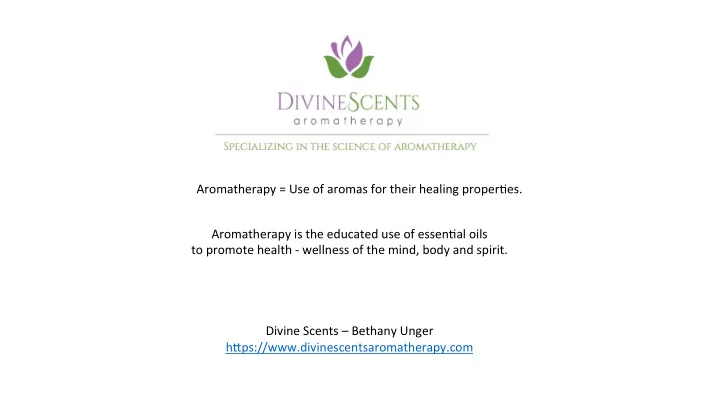

Aromatherapy ¡= ¡Use ¡of ¡aromas ¡for ¡their ¡healing ¡proper4es. ¡ Aromatherapy ¡is ¡the ¡educated ¡use ¡of ¡essen4al ¡oils ¡ ¡ to ¡promote ¡health ¡-‑ ¡wellness ¡of ¡the ¡mind, ¡body ¡and ¡spirit. ¡ ¡ ¡ ¡ ¡ Divine ¡Scents ¡– ¡Bethany ¡Unger ¡ hBps://www.divinescentsaromatherapy.com ¡ ¡ ¡
What ¡Is ¡an ¡Essen4al ¡Oil? ¡ Essen4al ¡oils ¡are ¡extracted ¡from ¡a ¡flower, ¡plant ¡or ¡tree. ¡ ¡ ¡ The ¡components ¡that ¡make ¡up ¡an ¡essen4al ¡oil ¡are ¡already ¡in ¡the ¡plant. ¡ ¡ ¡ ¡ Essen4al ¡oils ¡can ¡come ¡from ¡many ¡different ¡parts ¡of ¡the ¡plant, ¡and ¡each ¡ ¡ part ¡is ¡specific ¡to ¡a ¡par4cular ¡oil. ¡For ¡example, ¡rose ¡essen4al ¡oil ¡comes ¡ ¡ from ¡the ¡rose ¡petals, ¡lemon ¡is ¡produced ¡from ¡the ¡peel, ¡juniper ¡is ¡produced ¡ ¡ from ¡the ¡berries, ¡valerian ¡from ¡a ¡root, ¡and ¡cinnamon ¡from ¡the ¡leaf ¡or ¡bark. ¡ ¡ The ¡key ¡factors ¡of ¡the ¡quali4es ¡of ¡an ¡essen4al ¡oil ¡include: ¡the ¡4me ¡of ¡day ¡and ¡4me ¡of ¡year ¡ the ¡plant ¡material ¡is ¡harvested, ¡the ¡region ¡of ¡the ¡world ¡as ¡well ¡as ¡the ¡temperature ¡of ¡the ¡ region. ¡Each ¡of ¡these ¡factors ¡plays ¡a ¡very ¡important ¡part ¡in ¡producing ¡an ¡oil ¡that ¡renders ¡the ¡ desired ¡chemistry ¡so ¡it ¡will ¡have ¡therapeu4c/func4onal ¡impact. ¡ ¡ How ¡are ¡essen4al ¡oils ¡extracted? ¡The ¡methods ¡used ¡include ¡dis4lla4on, ¡expression ¡(also ¡ referred ¡to ¡as ¡cold ¡pressed), ¡solvent/absolute ¡extrac4on, ¡CO 2 ¡extrac4on, ¡macera4on ¡and ¡ effleurage. ¡ ¡ ¡ Essen4al ¡oils ¡are ¡very ¡concentrated. ¡Example ¡-‑ ¡Did ¡you ¡know ¡it ¡takes ¡approximately ¡2,000 ¡ rose ¡petals ¡to ¡make ¡1 ¡lb. ¡of ¡rose ¡essen4al ¡oil? ¡
Dis$lla$on: ¡The ¡process ¡of ¡passing ¡ steam ¡through ¡plant ¡material. ¡ 1. ¡Load ¡plant ¡material ¡into ¡the ¡s4ll, ¡ usually ¡copper ¡or ¡stainless ¡steel ¡ 2. ¡Steam ¡or ¡water/steam ¡passes ¡ through ¡the ¡s4ll. ¡ 3. ¡The ¡steam ¡breaks ¡down ¡the ¡plant ¡ material ¡and ¡removes ¡the ¡ components ¡of ¡the ¡plant ¡in ¡the ¡form ¡ of ¡vapor. ¡ 4. ¡Oil ¡and ¡water ¡vapor ¡move ¡to ¡the ¡ s4ll’s ¡condenser, ¡where ¡the ¡steam ¡ changes ¡back ¡to ¡water ¡or ¡oil ¡droplets. ¡ 5. ¡The ¡water ¡and ¡oil ¡separate. ¡Most ¡ oaen, ¡but ¡not ¡always, ¡the ¡oils ¡sits ¡on ¡ the ¡surface. ¡ 6. ¡Oil ¡is ¡captured ¡by ¡pouring ¡the ¡water ¡ off, ¡leaving ¡the ¡essen4al ¡oil. ¡
Like ¡the ¡tree ¡VOCs ¡(vola4le ¡organic ¡compounds) ¡that ¡are ¡men4oned ¡in ¡ Lab ¡Girl, ¡ essen4al ¡oils ¡are ¡also ¡vola4le. ¡This ¡means ¡that ¡essen4al ¡oils ¡ can ¡evaporate ¡and ¡easily ¡turn ¡into ¡vapor. ¡The ¡vapor ¡of ¡the ¡oil ¡when ¡ released ¡into ¡the ¡air ¡travels ¡as ¡molecules. ¡ ¡ ¡ ¡ These ¡molecules ¡travel ¡to ¡your ¡nose. ¡From ¡the ¡minute ¡an ¡aroma ¡hits ¡ your ¡nose, ¡there ¡is ¡a ¡process ¡that ¡occurs. ¡In ¡this ¡process, ¡there ¡are ¡four ¡ key ¡concepts ¡that ¡are ¡important ¡to ¡understand: ¡Detect, ¡Transmit, ¡ Perceive ¡and ¡Analyze. ¡ ¡ DETECT: ¡Essen4al ¡oil ¡molecules ¡travel ¡up ¡the ¡nose ¡into ¡the ¡nasal ¡cavity, ¡ where ¡they ¡come ¡into ¡contact ¡with ¡chemoreceptors. ¡When ¡an ¡odor ¡ molecule ¡s4mulates ¡a ¡chemoreceptor, ¡changes ¡to ¡your ¡brain ¡occur. ¡ ¡ TRANSMIT: ¡The ¡change ¡to ¡your ¡brain ¡is ¡caused ¡by ¡a ¡nerve ¡impulse ¡that ¡ creates ¡a ¡signal ¡(known ¡as ¡an ¡aroma ¡print) ¡that ¡travels ¡to ¡the ¡olfactory ¡ bulb. ¡ ¡ PERCEIVED ¡& ¡ANALYZED: ¡The ¡aroma ¡print ¡travels ¡to ¡other ¡parts ¡of ¡the ¡ brain ¡for ¡percep4on, ¡analysis, ¡storage ¡in ¡memory ¡and ¡emo4onal ¡ response. ¡
The ¡essen4al ¡oils ¡that ¡results ¡from ¡ this ¡process ¡contain ¡many ¡individual ¡ chemical ¡components. ¡While ¡these ¡ components ¡are ¡specific ¡to ¡each ¡ plant, ¡there ¡are ¡certain ¡ characteris4cs/molecular ¡structures ¡ that ¡are ¡oaen ¡found ¡in ¡certain ¡groups ¡ of ¡plants. ¡These ¡structures ¡ are ¡important ¡because ¡they ¡allow ¡ each ¡oil ¡to ¡be ¡categorized ¡based ¡ on ¡its ¡func4on ¡(or ¡therapeu4c ¡ property). ¡An ¡example ¡of ¡these ¡ structures ¡would ¡be ¡esters, ¡alcohols ¡ and ¡terpenes. ¡ derekcarrsavvy-chemist.blogspot.com ¡
Linalool ¡ Caryophyllene ¡ (Using ¡the ¡image ¡to ¡the ¡right.) ¡If ¡ you ¡were ¡able ¡to ¡look ¡inside ¡the ¡ essen4al ¡oil ¡Coriander ¡seed, ¡you ¡ would ¡see ¡structures ¡like ¡Linalool ¡ and ¡Pinene, ¡floa4ng ¡around; ¡or ¡ perhaps ¡Thyme, ¡which ¡contains ¡ Caryophyllene ¡and ¡Carvacrol ¡in ¡its ¡ composi4on. ¡ Essen4al ¡oils ¡are ¡just ¡made ¡up ¡of ¡ a ¡bunch ¡of ¡structures. ¡If ¡you ¡ understand ¡these ¡structures, ¡ you ¡can ¡understand ¡the ¡ func4ons ¡of ¡your ¡oil. ¡ ¡ ¡ Take ¡Terpenes/Terpenoids, ¡for ¡ example. ¡They ¡are ¡known ¡for ¡ an4-‑inflammatory, ¡an4sep4c, ¡ an4viral ¡and ¡bactericidal ¡ therapeu4c ¡ac4ons. ¡This ¡then ¡ Pinene ¡ Carvacrol ¡ tells ¡you ¡how ¡you ¡should ¡ use ¡your ¡oil. ¡ Wikipedia ¡
Lavender ¡ -‑ ¡made ¡from ¡the ¡dis4lled ¡flowers. ¡ ¡ ¡Analgesic, ¡an4depressant, ¡an4-‑inflammatory, ¡an4bacterial, ¡ ¡ ¡ Uses: ¡skin ¡healing, ¡seda4ve ¡ Bergamot ¡ -‑ ¡obtained ¡by ¡expression ¡from ¡the ¡fruit ¡peel ¡ ¡ An4depressant, ¡deodorant, ¡an4-‑viral, ¡an4-‑inflammatory ¡ ¡ Uses: ¡mood ¡support ¡ ¡ Sandalwood ¡ -‑ ¡obtained ¡by ¡dis4lling ¡the ¡root ¡and ¡heartwood ¡of ¡the ¡sandal ¡tree ¡ ¡ An4depressant, ¡an4fungal, ¡seda4ve ¡ ¡ Uses: ¡stress, ¡tension, ¡insomnia, ¡infec4on ¡ ¡ ¡
Recommend
More recommend